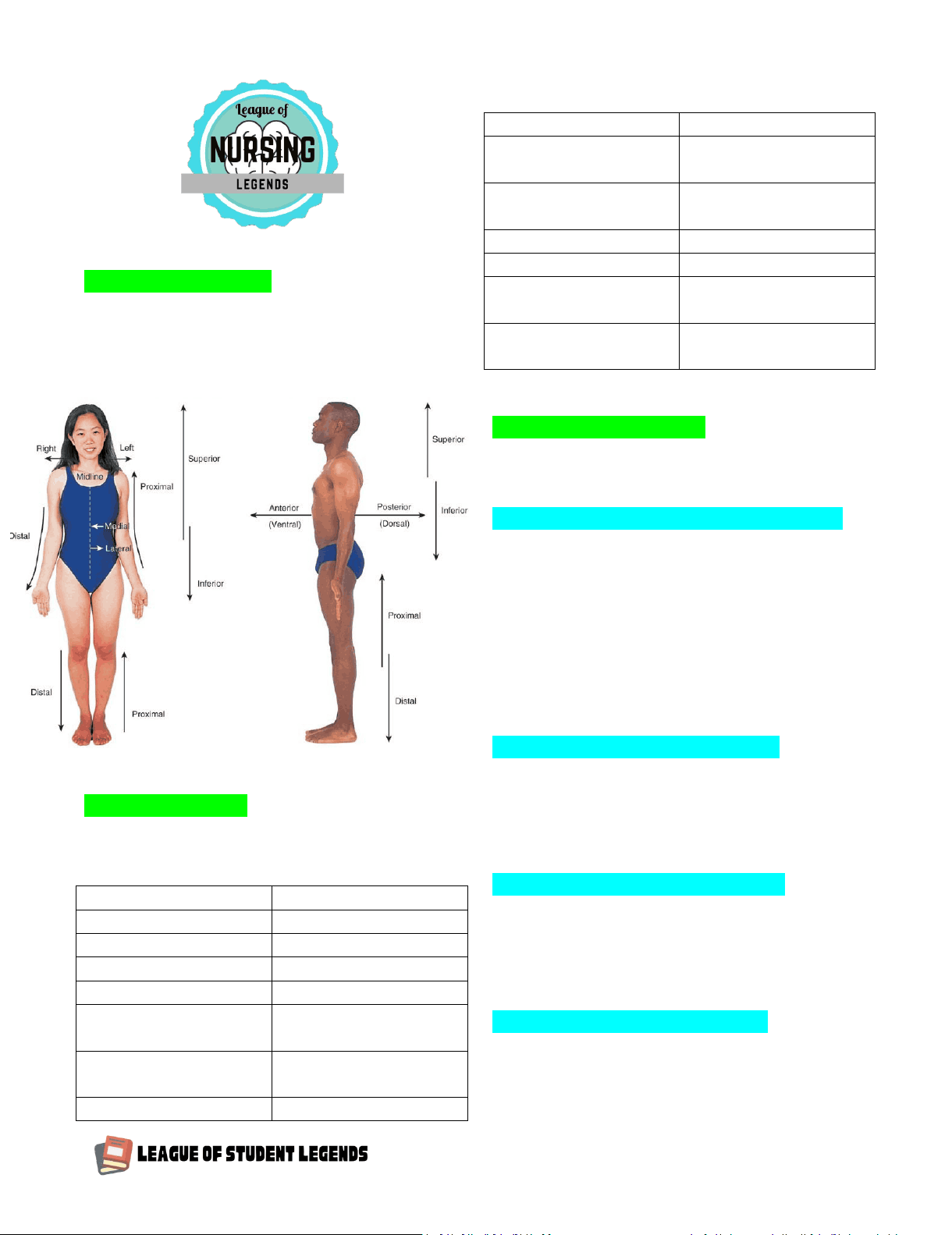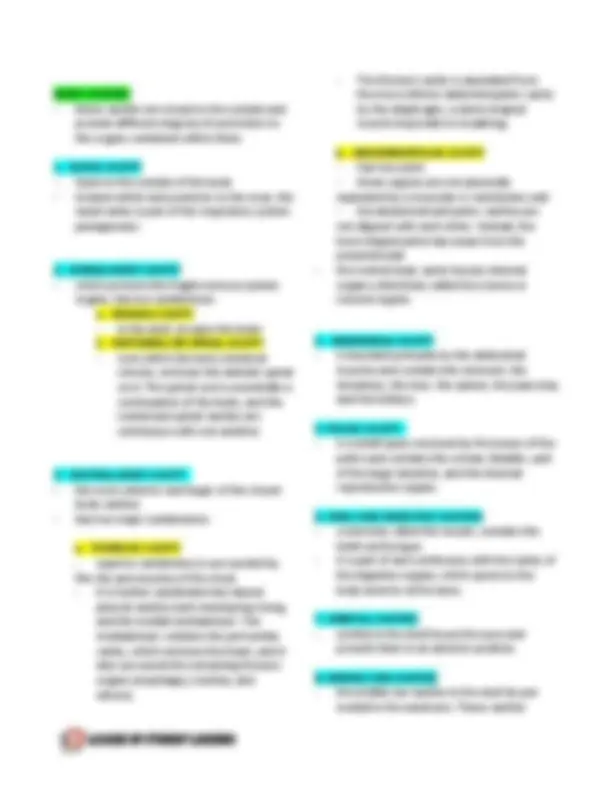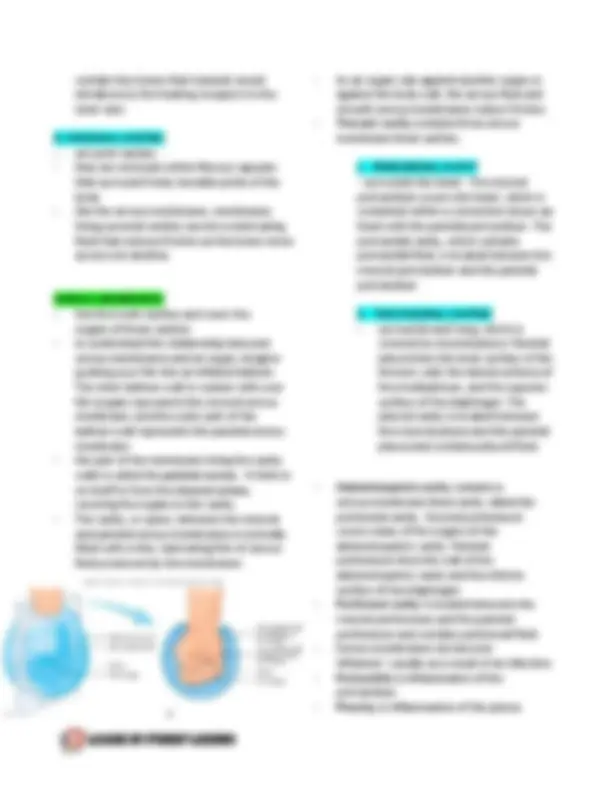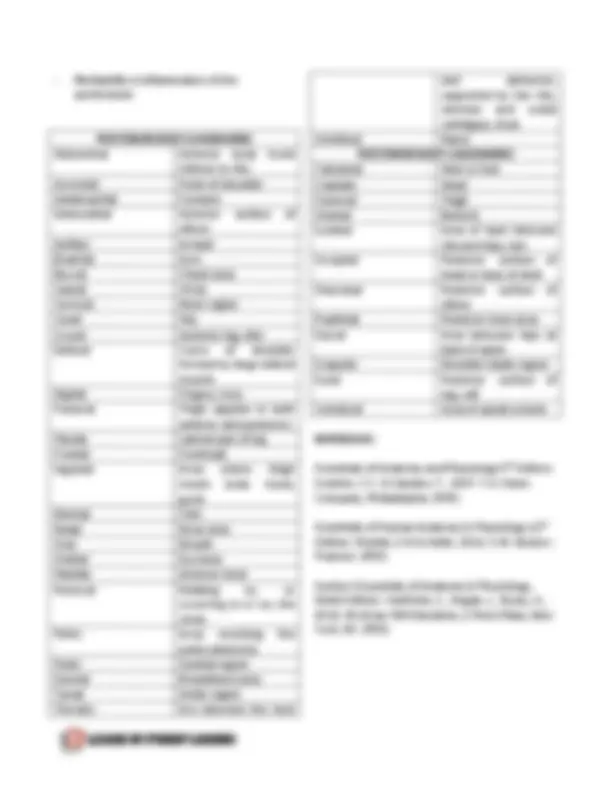





Study with the several resources on Docsity

Earn points by helping other students or get them with a premium plan


Prepare for your exams
Study with the several resources on Docsity

Earn points to download
Earn points by helping other students or get them with a premium plan
Community
Ask the community for help and clear up your study doubts
Discover the best universities in your country according to Docsity users
Free resources
Download our free guides on studying techniques, anxiety management strategies, and thesis advice from Docsity tutors
Anatomy and Physiology applicable for all preparatory medicine courses.
Typology: Summaries
1 / 6

This page cannot be seen from the preview
Don't miss anything!




- in the anatomical position, the body is standing erect and facing forward, the feet are together, and the arms are hanging at the sides with the palms facing forward
- describe parts of the body relative to each other
TERM DEFINITION Supine Lying face upward Prone Lying face downward Superior Higher/ above Inferior Lower/ below Anterior Front/ Toward the front of the body Posterior Back/ toward the back of the body Ventral Belly/ Toward the belly
Dorsal Back/ Toward the back Proximal Nearest/ Closer to a point of attachment Distal Distant/ Farther from a point of attachment Medial Toward the midline Lateral Away from the midline Superficial Toward to the surface of the body Deep Toward the interior of the body
CENTAL REGION OF THE BODY (AXIAL PARTS)
**1. Head
UPPER LIMB (APPENDICULAR PARTS)
1. Arm- extends from the shoulder to the elbow 2. Forearm- extends from the elbow to wrist **3. Wrist
LOWER LIMB (APPENDICULAR PARTS)
1. Thigh- extends from the hip to the knee 2. Leg- extends from the knee to the ankle **3. Ankle
ABDOMEN (APPENDICULAR PARTS)
- often subdivided superficially into four sections or quadrants by to imaginary lines that intersect at the navel
a. Quadrants- right-upper (RUQ), left-upper (LUQ), right-lower (RLQ), and left-lower (LLQ) b. Regions- uses four imaginary lines that created an imaginary tic-tac-toe figure on the abdomen, resulting nine regions:
1. Epigastric- located superior to the umbilical region 2. Right hypochondriac- lie lateral to the epigastric region and deep to the ribs (chondro = cartilage)
Sagittal Plane Runs vertically through the body and separates it into right and left parts Median Plane A sagittal plane that passes though the midline of the body, dividing it into equal right and left halves Transverse/ Horizontal Plane
Runs parallel to the surface of the ground, dividing the body into superior and inferior parts Frontal/ Coronal Plane Runs vertically from right to left and divides the body into anterior and posterior parts Longitudinal Section A cut through the long axis of the organ Transverse Section/ Cross Section
A cut at a right angle to the long axis Oblique Section A cut is made across the long axis at other than a right angle
contain tiny bones that transmit sound vibrations to the hearing receptors in the inner ears
9. SYNOVIAL CAVITIES
- line the trunk cavities and cover the organs of these cavities
Abdominal Anterior body trunk inferior to ribs Acromial Point of shoulder Antebrachial Forearm Antecubital Anterior surface of elbow Axillary Armpit Brachial Arm Buccal Cheek area Carpal Wrist Cervical Neck region Coxal Hip Crucal Anterior leg; shin Deltoid Curve of shoulder formed by large deltoid muscle Digital Fingers, toes Femoral Thigh (applies to both anterior and posterior) Fibular Lateral part of leg Frontal Forehead Inguinal Area where thigh meets body trunk; groin Mental Chin Nasal Nose area Oral Mouth Orbital Eye area Patellar Anterior knee Pectoral Relating to, or occurring in or on, the chest Pelvic Area overlying the pelvis anteriorly Pubic Genital region Sternal Breastbone area Tarsal Ankle region Thoracic Are between the neck
and abdomen, supported by the ribs, sternum and costal cartilages; chest Umbilical Navel POSTERIOR BODY LANDMARKS Calcaneal Heel or foot Cephalic Head Femoral Thigh Gluteal Buttock Lumbar Area of back between ribs and hips, loin Occipital Posterior surface of head or base of skull Olacranal Posterior surface of elbow Popliteal Posterior knee area Sacral Area between hips at base of spine Scapular Shoulder blade region Sural Posterior surface of leg; calf Vertebral Area of spinal column
REFERENCE:
Essentials of Anatomy and Physiology 5th^ Edition. Scanlon, V.C. & Sanders, T., 2007. F.A. Davis Company, Philadelphia. (PDF)
Essentials of Human Anatomy & Physiology 12th Edition. Marieb, E.N & Keller, 2016. S.M. Boston : Pearson. (PDF)
Seeley’s Essentials of Anatomy & Physiology, Ninth Edition. VanPutte, C., Regan, J., Russo, A.,